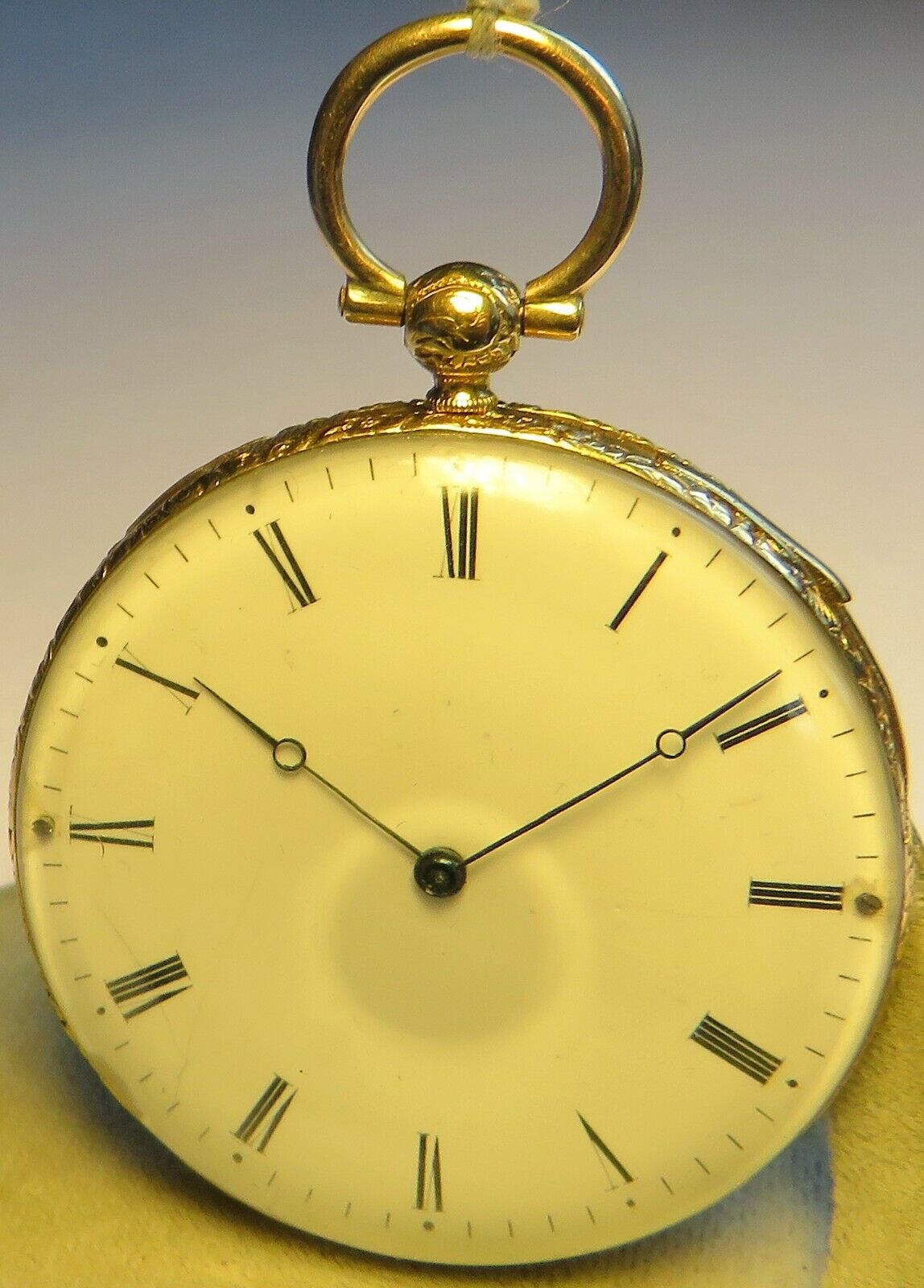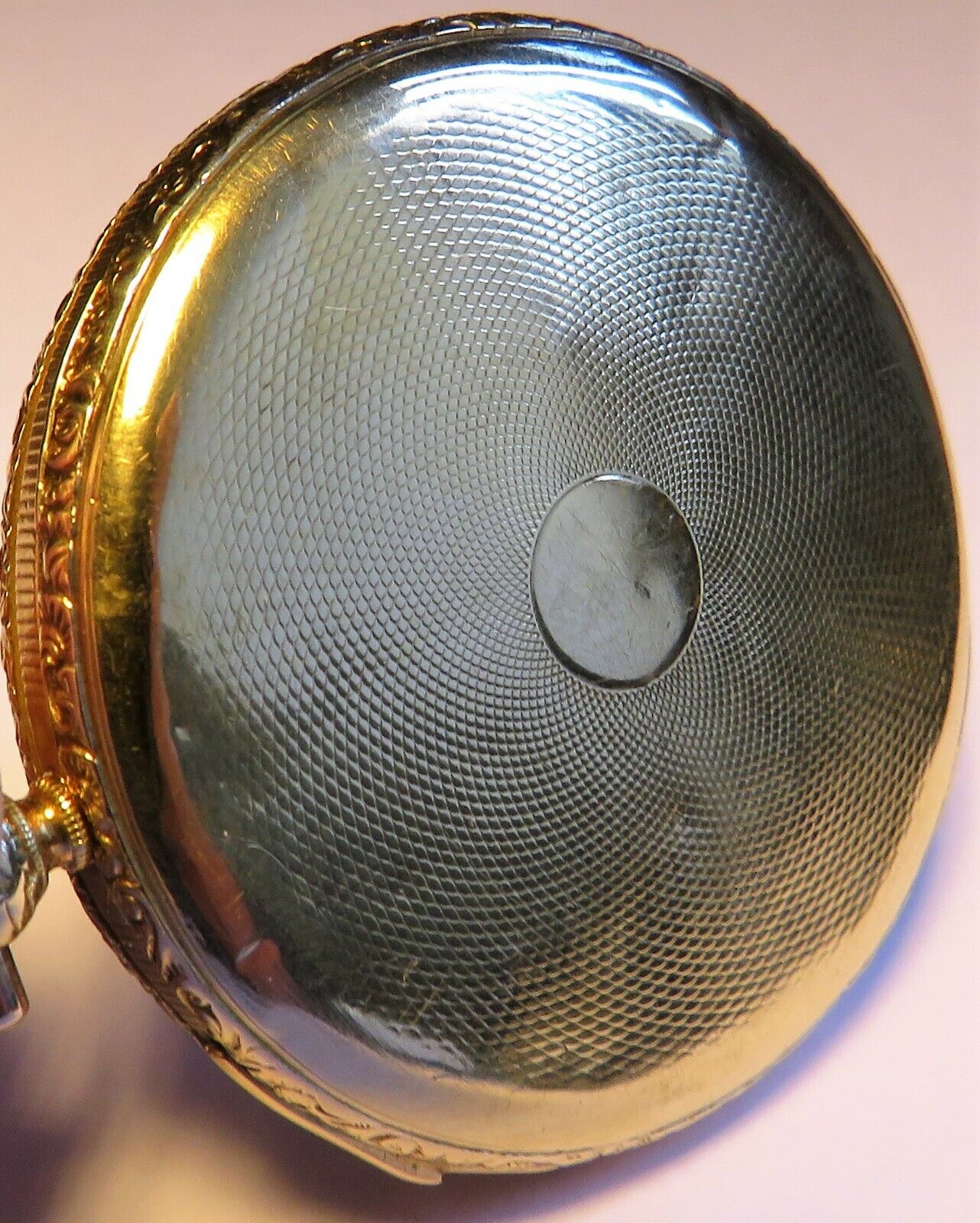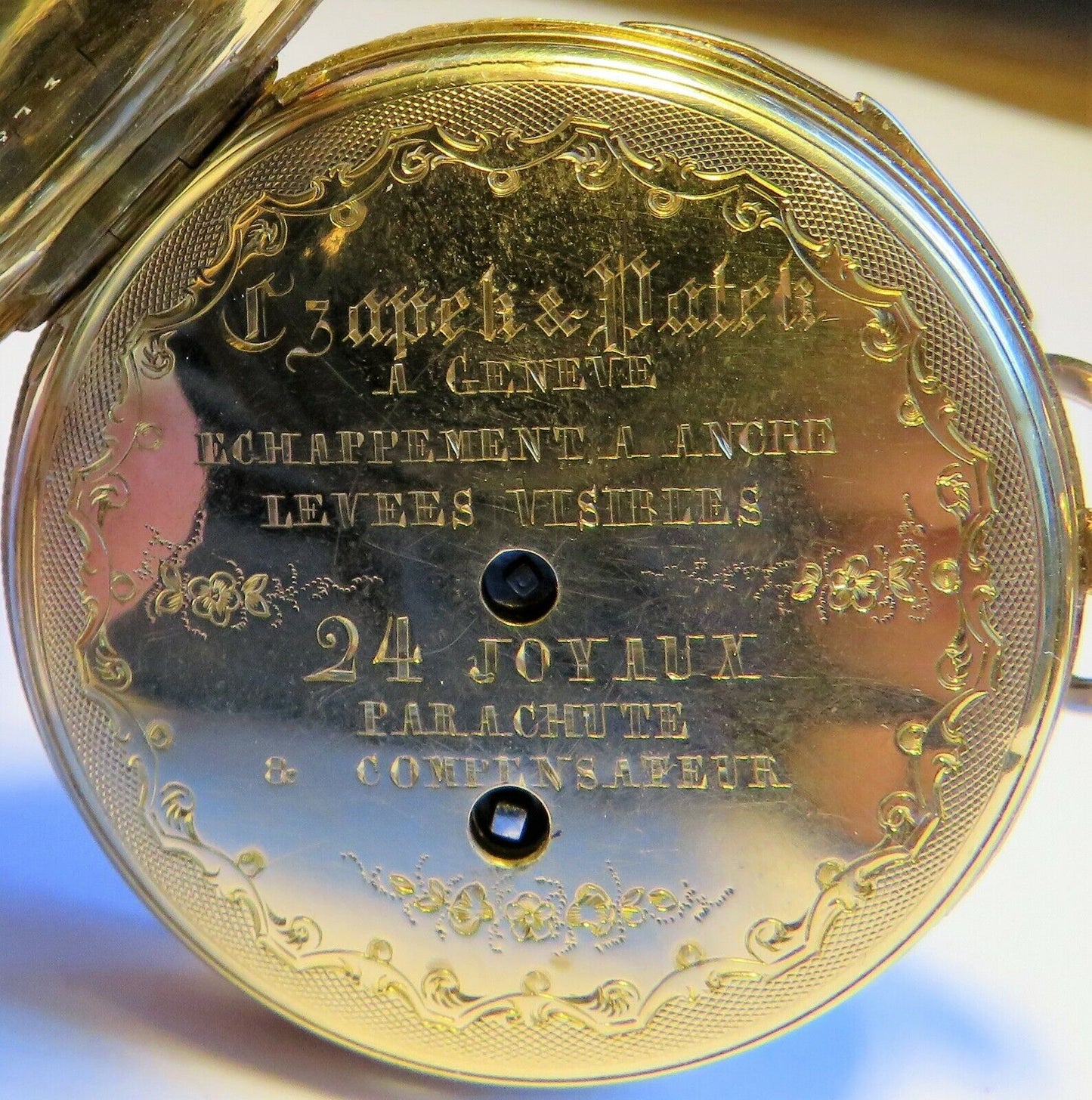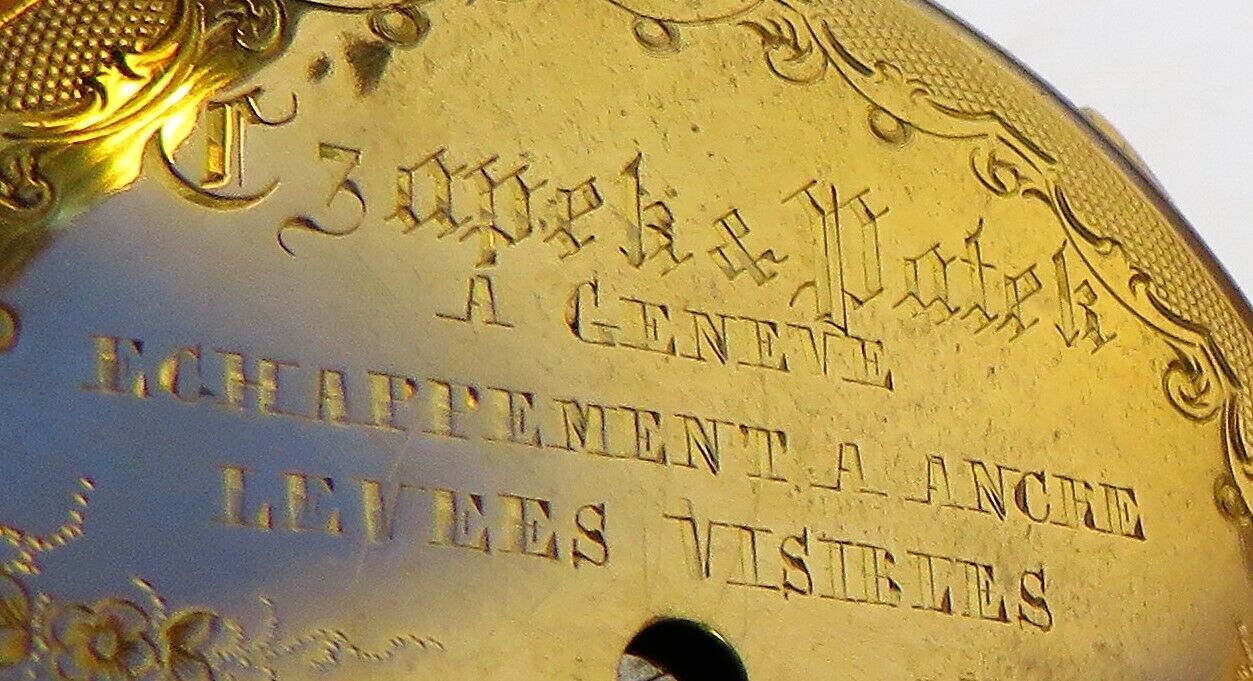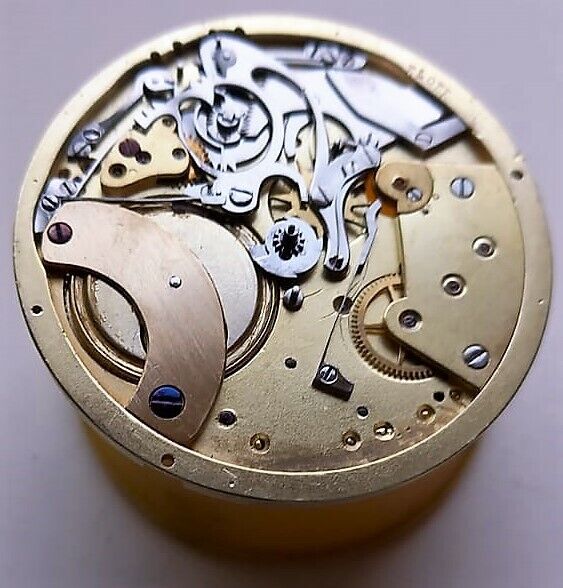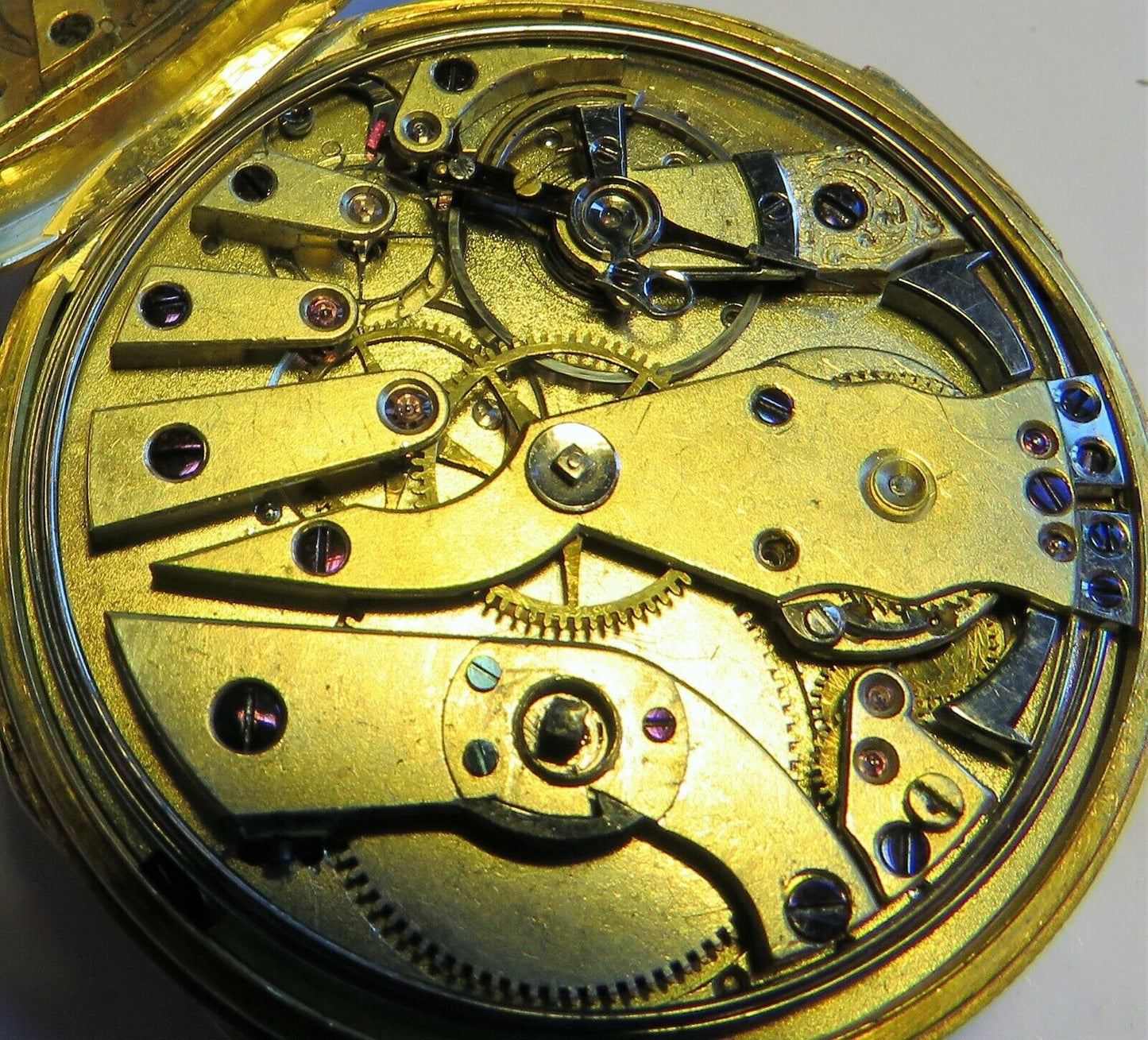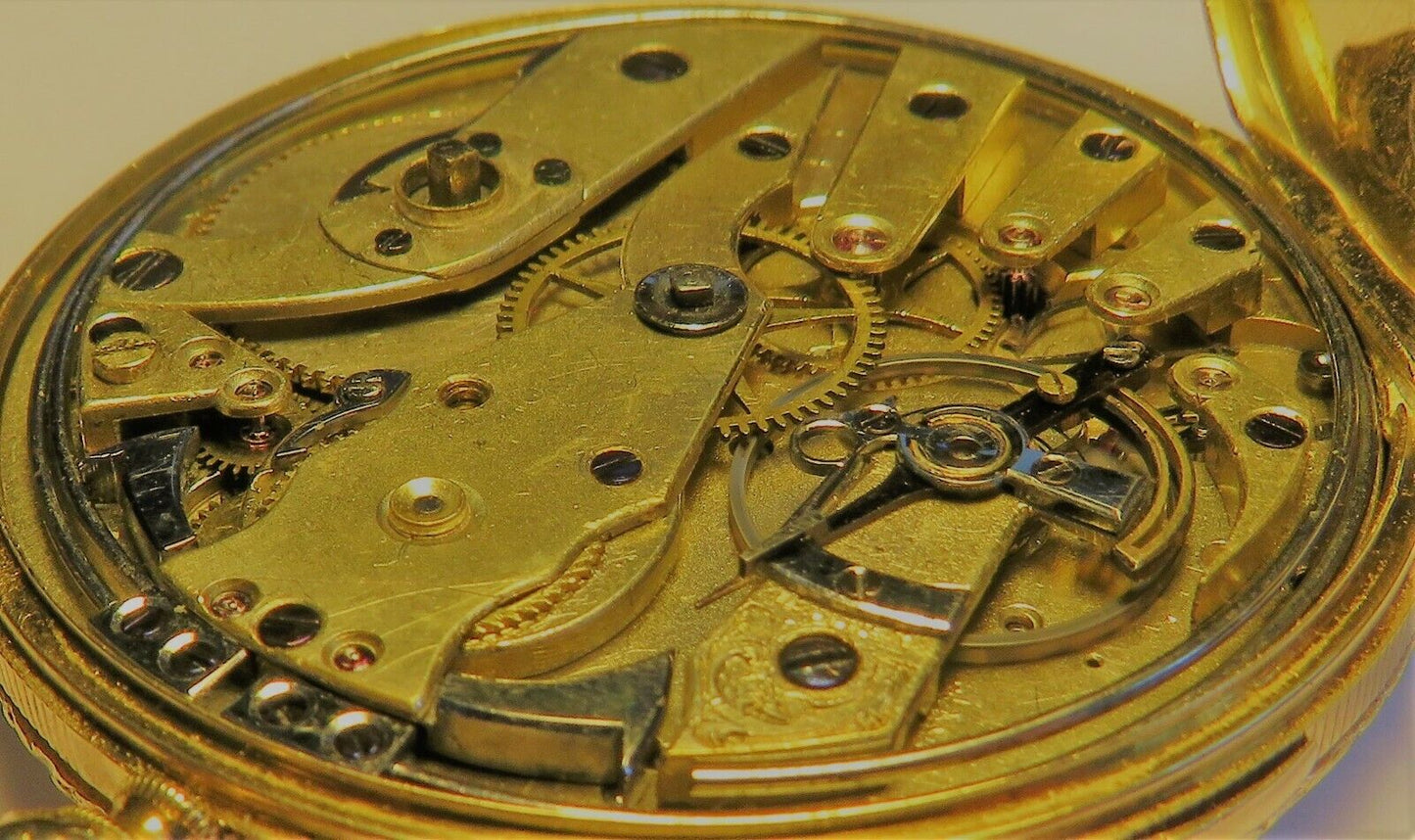Patek Philippe Czapek
Patek Philippe unique Quarter Repeater Pocket Watch 1840 Parachute
Patek Philippe unique Quarter Repeater Pocket Watch 1840 Parachute
Couldn't load pickup availability
First of all, I'd like to thank you for the hundreds of enthusiastic letters and questions over the past 12 months. Now the time has come: the restoration of this unique museum piece is complete, the watch is running, and will be offered for sale on eBay for a few months. If no buyer is found, it will go to a major international watch auction in winter 2025.
The subject of the offer is nothing less than a unique piece and museum piece of watch history: one of the earliest known repetition pocket watches - with certainty and according to a written expert opinion by Rolf Lang / Dresden, it is a unique piece / prototype from the hands of the legendary watchmaker Francois Czapek himself from the founding period of Patek Philippe - the signature proves that it is a piece from the 6 years of the founding phase of the now world-famous manufactory together with the gifted watchmaker Francois Czapek as partner
Regarding the authenticity and authenticity of this unique piece, we can colloquially guarantee: "The authenticity of this artifact has been determined and proven beyond doubt by genetic testing; we just don't have a birth certificate."
The background of the "genetic test" and the proof of authenticity:
This unique piece has now been in the care of the German watch restorer Rolf Lang (for many years chief restorer of the mathematical salon in Dresden, workshop manager at Lange&Söhne, IWC Schaffhausen, etc.) for a year.
During the restoration, Rolf Lang had a total of five identical Patek/Czapek repeater pocket watches from the earliest era from our collection at his disposal for comparison. These included some with an extract from the Patek archives, some "correctly" signed Patek watches, one with an extract from the archives, some that Czapek himself had further developed from this prototype after his retirement, and some that Patek Philippe itself had further developed and brought to series production, although these were without parachute shock protection and were "regressed" to the classic cylinder escapement, simply because they could not handle the newly invented escapement and could not reliably produce such a mechanism.
All five comparison examples match the complex axle alignment in every respect, down to the hundredth of a millimeter, and therefore verifiably originate from the first prototype, handcrafted by Francois Czapek himself, which is offered here. This is what the term "genetic test" means; it is an irrefutable fact that proves the provenance and origin of this unique prototype.
The German watch restorer legend Rolf Lang will be happy to assist the buyer of the artifact after purchase to explain his investigations and the background of his authenticity report.
For the evaluation and price estimation of this unique artifact, it should be mentioned that currently only one exclusive handcrafted watch by the watchmaking genius Francois Czapek is offered worldwide on Chrono24
Apart from the magnifying glass painting, this watch does not have any technical innovations or even unique features, special complications such as repeater, parachute, bimetal temperature compensation, anchor escapement, etc. and does not originate from the 6 years of the founding of the world-famous Patek Philippe manufactory. It is only a Czapek & Cie after 1850 and not a real "Patek & Czapek".
Nevertheless, the price of this later original Czapek after 1850 is over 125,000 Euros.
Included is, of course, a detailed restoration report with corresponding photos as well as a legally binding expert opinion by Rolf Lang, which derives and proves the provenance and lineage of the watch from the founding years of the Patek Philippe watch manufactory before 1844 in comparison with many other pieces of the era.
Unfortunately, it is not possible to obtain an extract from the Patek Philippe archives; this is refused for no apparent reason, presumably because they have some problems with the name "Francois Czapek" and the fact that he was by far the better watchmaker and developer than his successor "Adrien Philippe", who still bears his name today.
Patek Philippe trades at absolute top prices – not officially, but every industry insider knows this… – with its own historical models from the 19th century, and some very special pieces have even been auctioned directly at the Patek Museum in Geneva for several million euros.
I am not saying "we suspect" but "we cannot explain Patek Philippe's behavior any other way than that they deliberately refuse to provide an archive extract in order to prevent the unique, museum-quality prototype of this offering with a certificate of authenticity from receiving the international attention and reporting it definitely deserves due to its historical provenance and uniqueness.
It cannot be ruled out that this unique prototype may be prevented from being offered at a major international auction, where it could compete with the company's own, possibly less rare and exclusive models, thus robbing them of attention and purchasing power in the collector market.
I have been working with Rolf Lang almost daily for the past 12 months to research and clarify the provenance of this unique piece of watch history. It is important to note that Rolf Lang had access not only to the example offered for sale during the restoration and to prepare his authenticity report, but also to five identical models from Patek Philippe/Francois Czapek after 1845.
Lang completely disassembled and overhauled all six watches, comparing even the smallest screws, gaps, shafts, and material thicknesses in the original. In his detailed appraisal, which the buyer will receive in the original, and which I will, of course, not publish here "for free" after a nearly five-figure investment and cost, Rolf Lang demonstrates in minute detail which elements of the magnificent movement originated with Czapek and which are Patek standards.
It's worth noting the historical fact that the watchmaking genius Francois Czapek was by far the better watchmaker than his "successor" at Patek: Adrien Philippe. After Francois Czapek's departure, Patek and Philippe needed years to regain the technical level and skill that Czapek had already achieved when he left in 1845. Examples of this work include the Parachute shock protection and Czapek's extremely early, ultra-fine lever escapement.
For years after Czapek's departure, the Patek watch manufacturer was only able to incorporate comparatively primitive cylinder escapements into its watches...
In addition to the expert opinion of the German watch restoration legend Rolf Lang, who certifies this unique piece of watch history without any doubt as a "genuine, extremely early Patek / Czapek watch from the founding period of Patek Philippe between 1839 and 1845", a very simple fact also proves that the unique prototype originates from the house of Patek and the era 1839 - 1845.
Lang clearly demonstrates, using historical watches of unquestionable provenance, signed and certified by Patek Philip or Czapek&Cie, which elements of the movement represent Patek standards and which are from the personal hand of Francois Czapek.
It's obvious to any layman that a watch or movement with Patek and Czapek elements must come from Patek! Francois Czapek, who was technically far ahead of his successor, Adrien Philippe, would have had neither the legal right nor reason to use any Patek elements after his retirement in 1845, as all his developments were far superior to those of Patek/Philippe.
Patek Philippe – or for a few years "Patek & Cie" – on the other hand, had every right and reason to copy and continue to use all of Czapek's innovations as far and as long as possible, which they failed to do with the "Czapek lever escapement" for many years.
For the above reason, a watch with Patek and Czapek elements cannot come from Czapek - or rather "Czapek & Cie" - after his retirement
Unfortunately, Patek Philippe today refuses to provide an archive extract for this piece of watch history, which would put an end to the discussion and research into its provenance. We tried three times (and paid for it...), and each time the response was "Archive extract not possible due to lack of consistency."
Logical queries from a paying customer such as "did prototypes between 1839 and 1845 even have case/serial numbers?", "which parameters do not match?" or "what type of watch/model is archived under the respective serial number?" are ignored and not answered.
From the accompanying email conversation, in the course of which Patek Philippe demonstrably tells untruths, i.e. lies, it is clear that these so-called "archive extracts" (incidentally mentioned in January 2021, the price increased by 150%...) are made without any involvement of a knowledgeable watchmaker from Patek or its museum by some "ladies from the administration", who presumably simply blindly compare numbers without any expertise about the Patek brand or historical watches.
If such numbers happen to be identical, then a historical watch is genuine and the chairman signs the certificate personally. If something doesn't fit or is missing, or isn't understood by the "ladies", then the watch is simply "not genuine" and loses 95% of its value on the collector's market.
Questions from a paying customer about this procedure, such as "when were serial numbers assigned?" or "in which year does your mysterious archive begin?" are not answered, and my offer to personally present the watch to the experts at the watch museum in Geneva is ignored and not answered.
Today's Patek Philippe company simply declares this unique artifact "not eligible for archive extracts," without any watchmaker—let alone museum staff—having ever seen it, or even taken photos of it. It's striking that in approximately 10 applications and emails, Patek never makes the statement "the watch is not genuine or does not originate from Patek," because that would make them liable for damages as a competitor if we succeed in proving its authenticity—as happened—they simply state "not eligible for archive extracts" without giving any reasons or answering any further questions.
Until new photos are available, the note: The watch is sold in perfect, fully restored condition (incl. dial!!) after restoration by one of Germany's best master watchmakers and legends: Rolf Lang, owner of the watch manufactory "Rolf Lang", personally with his own hands without any additional work (exception: dial).
This unique artifact belongs to the very highest league and class of luxury watches. No one can definitively estimate or state its actual value. It could fetch several six-figure prices bordering on seven figures at a specialist auction in the USA. The same or even more would be possible if I took it to China for two weeks and advertised it in the relevant forums, "This unique artifact is for sale and is currently in Beijing for two weeks for appraisal."
I will not do either, because I am neither a gambler nor a speculator and I earn - thanks to the unique art of Rolf Lang (some of the best German watchmakers refused the restoration because they were overwhelmed by the task ...) - fair money, no matter what price it goes for.
First of all, some basic information about the origins of the watch brand "Patek Philippe": Antoine Patek was not a watchmaker, but an entrepreneur. Patek himself never personally contributed to the technical innovations or sensations of the manufactory named after him; he was not even technically qualified to do so. Patek was the entrepreneur from the very beginning, or "the businessman," so to speak. For this reason, Antoine Patek always collaborated with the best watchmakers of his time: first with Francois Czapek, then with Antoine Philippe, the inventor of the crown winding mechanism.
Further information on the rarity assessment: in the 6 years of "Patek&Czapek" the manufactory had just 6 watchmakers and produced about 200 watches per year
In the six years of "Patek&Czapek," only about 1,000, and in any case fewer than 1,500, watches were built. All of them very high-quality precision pocket watches for the era, but of course only very, very few with a repeater, and just as naturally, even fewer of them have survived after 200 years...
The "standard" original Patek repeater movement without parachute shock protection and lever escapement is now historically documented. This original Patek movement forms the basis of the movement of our unique artifact and, of course, makes it a genuine Patek watch, as does the signature, the case number, and the fact that Francois Czapek crafted it during his time and as a partner of Patek between 1839 and 1845.
Apparently, the watchmaking genius Francois Czapek then withdrew – probably for several weeks – with this very movement and experimented to see whether this invention of the "competitor" Breguet, as well as the innovative anchor escapement, could be incorporated into the existing Patek movement, which would make Patek watches significantly more valuable and safer.
This was achieved: the movement of this museum artifact – thus likely a unique piece and/or prototype – is the only original Patek pocket watch from the early years in the first half of the 19th century to feature a perfectly functioning parachute shock protection (the chaton of the ruby bearing stone of the balance shaft is secured and dampened by a very small spring) and a very early lever escapement.
This magnificent artifact was certainly handcrafted by Francois Czapek himself over weeks of work (proof that this watch is 100% handmade follows below). This could also explain why Czapek signed it – obviously by his own hand or on his personal order – "Capek&Patek" and not "Patek&Czapek", precisely because it was developed and built with an innovation by him personally.
According to Rolf Lang, this could also be the reason for the "stamping error" discussed below and the suddenly appearing "0" in the case number, which makes it five-digit, cannot be correct from a purely numerical point of view and seemingly places the unique piece in a completely different production era (see below).
At the time of signing with an additional "false" zero, Czapek did not know whether this movement with Parachute shock protection would go into series production, so he marked the "Standard Patek Repetitions Movement" with standard case number with an additional "0" to indicate that this is a prototype and further development of the original movement.
Rolf Lang, founder of Germany's only owner-operated genuine watch manufacturer in Dresden, is a master watchmaker/watch restoration legend in Germany, one of only three certified watch restorers. Lang has trained hundreds of watchmakers and master watchmakers and has worked as chief developer in almost all of Glashütte's major watch factories, including Tutima and Lange & Söhne. He also served as workshop manager, chief designer, and prototype builder for many years during the reconstruction of Moser & Cie in Schaffhausen.
Rolf Lang was also chief restorer for 11 years in the world-famous "physical and mathematical salon in the Dresden Zwinger", a museum of world renown, founded 300 years ago by Augustus the Strong, where Rolf Lang restored world-renowned technical artifacts from 300 years ago with his own hands.
A restoration by Rolf Lang himself is certainly appropriate for this historical piece. Despite the impressive name, there is most likely no one at Patek Philippe who can even come close to Rolf Lang's qualifications and decades of experience.
Rolf Lang believes the case number of the artifact is not 11071, but 1171. The zero in the middle is intentional and serves to conceal a stamping error or to (clumsily...) identify a prototype. It is clearly visible that on the initially stamped outer cover, a "7" was stamped under the "0," which was subsequently corrected with a "0." The incorrect five-digit number was then stamped in full on the inner movement cover.
Why the employee corrected the actually correct "7" with a "0" over 170 years ago can of course no longer be determined, but it is absolutely clear that the middle digit of the five-digit number was - for whatever reason - corrected, i.e. added, and then incorporated as an error into the 2nd, inner movement cover embossing.
With a case number of 1171, the museum piece can be clearly assigned to the very earliest era of this globally legendary manufactory.
Because countless doubters or self-proclaimed "watch experts" and conspiracy theorists have once again reported and complained, just for your information: early Patek pocket watches never had a movement number engraved. The lack of a movement number is historically justified and does not indicate any lack of originality. However, the overstamped, incorrect case number is present three times, as usual and to be expected.
Yes, in my research, I too have found only - very few ... - photos of "Patek&Czapek" signatures, and so far none with "Czapek" in front. However, the claim "Patek always came first in the signature" is definitely not true. Someone made it online about 20 years ago, and it has apparently been copied again and again without reflection (Rolf Lang's statement). Many authentic early Patek movements are also signed "CP"—that is, Czapek/Patek and not "PC."
There is no historically reliable evidence or fact in the specialist literature that "Patek" always appeared at the front of the name. Czapek was just as brilliant a watchmaker as Patek, who was more active in the commercial field. The partners separated after just six years of disagreement. This separation was certainly preceded by a long period of resentment and arguments, presumably also by mutual disappointment. Against this background, it is entirely conceivable, if not likely, that Czapek, who probably spent weeks tinkering with this masterpiece of an early repeater pocket watch while Patek was "just in the office," would sometimes sign or have signed very special pieces "Czapek&Patek" out of emotion.
First comment by Rolf Lang after examining the unique piece:
"Every watch historian would love to have a project and find such a condition. The repeater isn't damaged, but after approximately 100 years of non-service, it had become extremely resinous and therefore couldn't function. This watch has been around forever, perhaps over 100 years, fortunately just sitting. Parts that normally fall off on their own or are easily removable were completely fixed by extreme resinification. The watch has probably not been serviced in the last 100 years or so, which was a rare stroke of luck for it. So all parts are present; everything is original except for traces of wear from the first 100 years, during which it was also serviced several times.
I will now restore all the removed parts of the repeater to their original condition, primarily the spoiled polishes, unfortunately spoiled by watchmakers...
As further evidence of the age and individual production, I was able to find a clear indication of handcrafting: very fine circular arcs can be seen on the plates, with the help of which the axis distances were determined and drawn by hand. Using a compass, these were finely engraved as a template in a barely perceptible manner.
Undoubtedly, this artifact is handcrafted and a genuine Patek, as evidenced by the signatures and a historically documented Patek reference movement, as well as its (small...) size and light weight. No other watch manufacturer during this era was capable of producing a genuine repeater pocket watch of such delicate dimensions. Furthermore, Rolf Lang has found an early repeater pocket watch clearly attributed to Patek Philippe in his inexhaustible archive, whose movement is 100% identical to the one in this offering.
Description of the museum piece of an early prototype Patek pocket watch quarter repeater with lever escapement:
The date of manufacture is less than 10 years before Jean Fabien Philippe joined the company and invented/patented a crown winding mechanism with setting function and registered the company name Patek Philippe, which is still valid today.
A very, very rare and valuable, unique museum-worthy artifact of watchmaking history, the likes of which are currently unequaled anywhere in the world! The artifact comes from a major German auction house, which can be verified at any time upon purchase, and not from any nebulous sources or "inheritances."
Very early (1840), solid gold pocket watch with quarter repeater, earliest parachute shock protection and very fine lever escapement, signed: Czapek & Patek (see photos), one of the very first repeater pocket watches ever produced by Patek
Given the age and value, I dare not check the gold content, probably 18 carat / 750 gold, but I do not want to take a sample from this piece of watch history in its dream state
"Czapek & Patek" signed open face watch with temperature compensation and repeater, ca. 1840-1845, case diameter: 43 mm, ca. 50.5 g, 18K gold, guilloché, dust cover inscribed "Czapek & Patek A Geneve", case number 1171 (and as already stated, not "11171"!!!)
High-precision movement, temperature compensation and parachute shock protection, hour and quarter-hour repetition, enamel dial, with a very fine hairline crack between the "7" and the "9" and an almost invisible mini chip in the edge area between the "7" and the "8", Breguet steel hands
The unique quality of this unique piece of watch history is demonstrated by its incredible size/smallness with 43mm diameter and only 8mm height including the domed mineral glass
Such a small size was not achieved by other well-known manufacturers in the following 150 years, completely and originally preserved, super rare piece from the earliest period/founding period "Czapek & Patek"
The dial has (had ...) 2 hairline cracks starting between the "7" and the "8" and tiny, restored chips on the original screw connections on the "3" and the "9"
Undoubtedly, the artifact of this offer belongs to the 1% to 2% of all watches worldwide, which are ideally suited as a lucrative investment object and whose value will certainly multiply in the coming years and decades.
It is well known that historical Patek Philippe watches achieve the highest prices ever at international auctions; only a few years ago, a Patek Philippe pocket watch from the 19th century was sold for almost 20 million dollars.
As mentioned, this unique, one-of-a-kind piece from the world's finest and most expensive watch manufacturer is superbly restored and, of course, fully functional. The potential hammer price for this unique Patek Philippe at an international auction with appropriate advance notice could be between €150,000 and €1 million!
Patek Philippe is the watch manufacturer with the highest appreciation in value for classic and antique special models worldwide in recent years and decades; an original Patek Philippe pocket watch has already fetched almost 20 million euros!
The restored movement starts and runs continuously, but we expressly point out that this is a museum prototype that was not developed or built for sale or daily use. Despite 12 months of restoration and adjustment, it can happen that in some position—as just happened when photographing—something in the smallest detail of the movement gets stuck, causing the movement to stop when touched, or in another position, it will then run fully again.
Reliability or accuracy were never the goal or idea of the watchmaking genius Francois Czapek, who only wanted to test whether it was possible to combine a quarter-hour repeater of less than 40mm in diameter with the new inventions "parachute shock protection" and an anchor escapement.
Legally speaking, if the artifact stops working for a buyer—and that will certainly happen—despite "total restoration," this does not constitute a defect or even a claim for damages or rescission against the seller. A buyer expressly agrees to this agreement by submitting a binding purchase offer.
The elaborate restoration was photo-documented, the restoration and authenticity report has not yet been completed by Rolf Lang, because he prefers working on historical pieces to writing reports. dr
